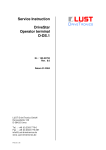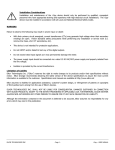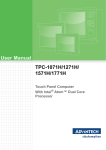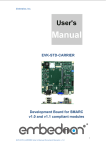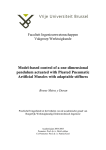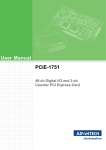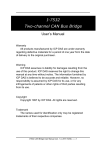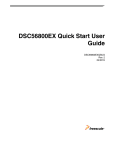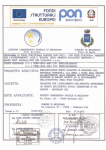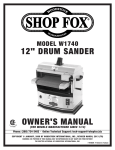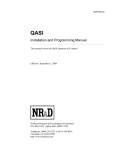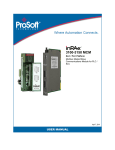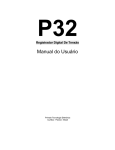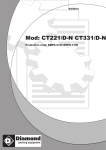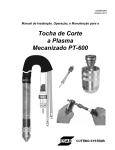Download QRIO 984LL Example - Niobrara R&D Corporation
Transcript
QRIO 984LL Example Manual QRIO 984LL Example Companion Manual This manual provides more detail on the QRIO 984LL Video demonstrating a Quantum PLC controlling Allen-Bradley 1771 (PLC5) I/O. Effective: January 14, 2011 Niobrara Research & Development Corporation P.O. Box 3418 Joplin, MO 64803 USA Telephone: (800) 235-6723 or (417) 624-8918 Facsimile: (417) 624-8920 http://www.niobrara.com Modicon, Square D, SY/MAX, Compact, Quantum, M340, Momentum, Premium are trademarks of Schneider-Electric. A-B, Allen-Bradley, ControlLogix, SLC, PLC are trademarks of Rockwell Automation. Subject to change without notice. © Niobrara Research & Development Corporation 2011. All Rights Reserved. System Layout Figure 1 System Layout Quantum Allen-Bradley I/O Simulator This demonstration video shows a simple Modicon Quantum PLC system controlling a remote rack of Allen-Bradley 1771 Series I/O using the Niobrara QRIO-002. The Quantum rack consists of a power supply, CPU, and the QRIO. The A-B rack consists of an ASB, a 16-bit discrete input card, a 16-bit output card, a 16 channel analog input card, a 4 channel analog output card, two 8-bit discrete input cards, and two 8-bit discrete output cards. A small simulator box is also attached that provides three toggle switches connected to inputs on the 24VDC 8-bit input cards, two 0-10Vdc potentiometers connected to two of the analog inputs, and a DC voltmeter connected to one of the analog outputs. Quantum Rack The Quantum system is a simple 3-slot rack with a CPS111 power supply in slot 1, a CPU 213 04A in slot 2, and the QRIO-002 in slot 3. RIO Port 1 of the QRIO is connected with the standard “Blue Hose” twin-axial cable to the A-B ASB. The standard 82 ohm terminator is installed across the clear and blue wires at the removable connector. QRIO 984LL Example Manual 3 Figure 2 Quantum Rack CPU 213 04 QRIO in Slot 3 Power Supply Clear Wire Shield Wire Blue Wire Terminator A-B Rack The Allen-Bradley rack is an 8-slot chassis. Removing the ASB allow the examining of the DIP switch on the rack backplane (See Figure 4). Consult the ASB user manual for IAD 16-bit Input OAD 16-bit Output Figure 3 A-B Rack OFE2 Analog Output IFE Analog Input IB 8-bit Input OB 8-bit Output IB 8-bit Input OB 8-bit Output ASB Group 0 Group 5 Group 1 Group 2 Group 3 Group 4 4 Group 7 Group 6 QRIO 984LL Example Manual complete information about the chassis DIP switch. (The QRIO may be considered to be the same as a PLC-5 Family, SLC, or ControlLogix scanner.) The video shows that the chassis is configured for the following: • SW1 = OFF (Outputs of the chassis are deenergized when a fault is detected.) • SW2 = ON (Remote restart enabled) • SW3 = OFF (Always OFF) • SW4 = OFF (Always OFF) • SW5 = ON • SW6 = OFF (SW5 ON + SW6 OFF = 1-slot addressing) • SW7 = OFF (Always OFF) • SW8 = OFF (Always OFF) Switches 5 and 6 determine the addressing of the chassis. This rack is set for 1-slot addressing. The ASB user manual goes into great detail about ½-slot, 1-slot, and 2-slot addressing with various 8-bit, 16-bit, and 32-bit discrete cards. Figure 4 A-B Rack DIP Switch SW2 = ON SW5 = ON All other switches are OFF The implication of 1-slot addressing is that every slot in the rack has 16 input bits and 16 output bits assigned. This wastes a lot of bits, but it is the only way to make it work. Sixteen bit input only cards use all 16 input buts but waste the 16 output bits. Output QRIO 984LL Example Manual 5 OAD 16-bit Output IAD 16-bit Input Figure 5 1-slot Bit Ranges OFE2 Analog Output IFE Analog Input ASB 81-96 1-16 17-32 IB 8-bit Input 33-48 49-64 65-80 OB 8-bit Output IB 8-bit Input OB 8-bit Output 113-128 97-112 1-slot Address assigns 16 bits IN and 16 bits OUT to every slot. These input bits and output coils must be reserved. cards only use the output bits and waste input bits. Eight bit cards only use the first 8 bits of the appropriate direction. Analog cards don't use the bits at all but they still must be assigned. 6 QRIO 984LL Example Manual ASB Configuration The QRIO supports ASB models of Series D and E. The ASB is configured by DIP switches. Consult the ASB user manual for complete information about the settings and consider the QRIO as a PLC-5, SLC, or ControlLogix Scanner. NOTE: The ASB user manual table 2.C shows the Rack # in Octal. The settings shown in Figure 6 are octal 12 = decimal 10 (8+2). Figure 6 ASB DIP Switches Switches 1&2 Set the baud rate 1ON, 2OFF = 57.6Kbps Switches 1-6 set the Rack Number in binary. Switches 3 and 5 OFF Corresponds to Rack = 10. QRIO 984LL Example Manual Switches 7&8 Set the 1st Group Number = 0 7 Figure 7 ASB Blue Hose Wiring Blue Wire Terminator Shield Wire Clear Wire The wiring of the ASB card simply connects the “Blue Hose” cable to the proper screw terminals. Also notice that since this is the last node on the network the 82ohm terminator is also installed across the clear and blue wires. 1771-IAD (16-bit 120VAC Discrete Input Card) Slot 0 holds a 16-bit discrete input card. It is difficult to see in the video, but three of the inputs on this card are hard-wired ON to 120VAC. Inputs 00, 15, and 17 (octal) are all ON. These inputs are not used in the sample ladder logic in the Quantum, but are there simply to assist the understanding of the bit mapping from the A-B system to the Modicon. The QRIO's I/O Scanner maps these 16 inputs into bits 1x0001 through 1x00016. NOTE: The A-B rack is configured for 1-slot addressing. This means that this slot consumes 16-1x input bits and 16-0x output coils. Therefore, coils 0x00001 through 0x000016 are assigned to this slot and may not be used elsewhere in the PLC program. 8 QRIO 984LL Example Manual Quantum Address Card Input (octal) Notes 1x00001 00 Wired always ON 1x00002 01 1x00003 02 1x00004 03 1x00005 04 1x00006 05 1x00007 06 1x00008 07 1x00009 10 1x00010 11 1x00011 12 1x00012 13 1x00013 14 1x00014 15 1x00015 16 1x00016 17 Wired always ON Wired always ON Table 1: 1771-IAD Mapping 1771-OAD (16-bit 120VAC Discrete Output Card) Slot 1 holds a 16-bit discrete output card. Two of the outputs are controlled in the Quantum's ladder logic. Careful viewing of the video will show switch 3 changing the state of this card's Outputs 00 and 16 (octal) (Modicon coils 0x00017 and 0x00031). The QRIO's I/O Scanner maps these 1 He6 outputs to coils 0x00017 through 0x00032. NOTE: The A-B rack is configured for 1-slot addressing. This means that this slot consumes 16 0x coils as well as 16 1x input bits. These 1x bits will always be set to zero by the QRIO. QRIO 984LL Example Manual 9 Quantum Address Card Output (octal) Notes 0x00017 00 Tied to Toggle Switch #3 0x00018 01 0x00019 02 0x00020 03 0x00021 04 0x00022 05 0x00023 06 0x00024 07 0x00025 10 0x00026 11 0x00027 12 0x00028 13 0x00029 14 0x00030 15 0x00031 16 0x00032 17 Tied to Toggle Switch #3 Table 2: 1771-OAD Mapping 1771-OFE2 (12-bit 4-channel Analog Output Card) Slot 2 contains a 4-channel analog output card. This card is configured (internal jumpers) for 0-10VDC outputs. Output channel 1 is wired directly to the analog voltmeter. Output channels 2, 3, and 4 are not used in this example. The 1-slot addressing of the A-B chassis ends up mapping discrete inputs 1x00033 through 1x00048 and outputs 0x00033 through 0x00048 to this card. These bits and coils are not used within the Quantum's ladder logic but their reservation is required. Allen-Bradley systems control this card with a function called a block transfer write. The QRIO uses the standard Modicon MSTR function to achieve control. The MSTR requires two blocks of Holding Registers (4x), one for the control block, and one for the data to be written to the analog output card. The ladder logic used to control the MSTR to write the data is shown on page 26. The control and data blocks are shown below: 10 QRIO 984LL Example Manual Quantum Value Address (hex) Value (decimal) Notes 4x0100 0001 1 1=MSTR Write Command 4x0101 0000 0 Error Code Returned by QRIO 4x0102 000D 13 13 words of data in the write 4x0103 0000 0 Always 0 4x0104 0301 769 High byte = QRIO Slot Number (3) Low byte = QRIO Port Number (1) 4x0105 000A 10 Logical Rack number of Write (10) 4x0106 0000 0 Interface Group Number of Target (0) 4x0107 0002 2 ASB Group Number of Target (2) 4x0108 0000 0 Always 0 for 1-slot addressing Table 3: Analog Output MSTR Control Block NOTE: The scaling for channel 1 was set to match the scaling of the analog input #1 so a simple ADD16 could be used to copy the analog input 1 to analog output 1. NOTE: For more information about the data block written to the OFE, consult the OFE user manual. Quantum Value Value Notes Address (hex) (decimal) 4x0120 0669 1641 Channel 1 Data Value 4x0121 07D0 2000 Channel 2 Data Value 4x0122 07D0 2000 Channel 3 Data Value 4x0123 07D0 2000 Channel 4 Data Value 4x0124 8000 32768 Integer Data, positive scales, positive data 4x0125 0000 0 Channel 1 Min. Scale Value 4x0126 0FFF 4095 Channel 1 Max. Scale Value 4x0127 0000 0 Channel 2 Min. Scale Value 4x0128 0FFF 4095 Channel 2 Max. Scale Value 4x0129 0000 0 Channel 3 Min. Scale Value 4x0130 0FFF 4095 Channel 3 Max. Scale Value 4x0131 0000 0 Channel 4 Min. Scale Value 4x0132 0FFF 4095 Channel 4 Max. Scale Value Table 4: Analog Output MSTR Data Block QRIO 984LL Example Manual 11 1771-IFE (12-bit 16-channel Analog Input Card) Slot 3 contains a 16-channel analog input card. This card is configured for -10 to +10VDC inputs. Input channel 1 is wired directly to potentiometer #1 which provides a 0-10VDC input. Input channel 16 is wired to potentiometer #2 which also provides a 010VDC input. Input channels 2 through 15 are floating. Channel 1 is scaled to achieve a 0-4095 value for the 0-10VDC range. This range was chosen to allow a simple ADD16 command to copy the data from this analog input to the analog output card. Just for fun, Channel 16 is scaled to achieve a 0-1000 value for the 010VDC range. The 1-slot addressing of the A-B chassis ends up mapping discrete inputs 1x00049 through 1x00064 and outputs 0x00049 through 0x00064 to this card. These bits and coils are not used within the Quantum's ladder logic but their reservation is required. Allen-Bradley systems control this card using both a block transfer read and write. The QRIO uses the standard Modicon MSTR functions to achieve control. Each MSTR requires two blocks of Holding Registers (4x), one for the control block, and one for the data to be read from the card or the setup data written to the card. This card needs to be configured each time power is cycled on the A-B rack. Fortunately, the card gives a status bit that may be used to trigger the configuration write. The NOBT block in Network 5 of the 984LL program is this trigger. The ladder logic used to control the MSTR to read the data is shown on page 27. The control and data blocks are shown below: Quantum Value Address (hex) Value (decimal) Notes 4x0200 0002 2 2=MSTR Read Command 4x0201 0000 0 Error Code Returned by QRIO 4x0202 0014 20 20 words of data in the read 4x0203 0000 0 Always 0 4x0204 0301 769 High byte = QRIO Slot Number (3) Low byte = QRIO Port Number (1) 4x0205 000A 10 Logical Rack number of Write (10) 4x0206 0000 0 Interface Group Number of Target (0) 4x0207 0003 3 ASB Group Number of Target (3) 4x0208 0000 0 Always 0 for 1-slot addressing Table 5: Analog Input READ MSTR Control Block NOTE: For more information about the data block read from the IFE, consult the IFE user manual. 12 QRIO 984LL Example Manual Quantum Value Address (hex) Value (decimal) Notes 4x0220 0002 2 Diagnostics Bits (data out of range) 4x0221 0000 0 Underrange Bitmap 4x0222 8000 -32768 Overrange Bitmap 4x0223 7FFF 32750 Data Polarity Bitmap 4x0224 05E7 1511 Channel 1 Data 4x0225 FDED -531 Channel 2 Data 4x0226 FE6C -404 Channel 3 Data 4x0227 FECB -309 Channel 4 Data 4x0228 0345 837 Channel 5 Data 4x0229 FD4F -689 Channel 6 Data 4x0230 FE6C -404 Channel 7 Data 4x0231 FE5E -418 Channel 8 Data 4x0232 FEC7 -313 Channel 9 Data 4x0233 FE60 -416 Channel 10 Data 4x0234 FE6A -406 Channel 11 Data 4x0235 FED1 -303 Channel 12 Data 4x0236 FD9D -611 Channel 13 Data 4x0237 FD9F -609 Channel 14 Data 4x0238 FE9C -356 Channel 15 Data 4x0239 03E8 1000 Channel 16 Data Table 6: Analog Input READ MSTR Data Block The ladder logic used to control the MSTR to read the data is shown on page 28. The control and data blocks are shown below: QRIO 984LL Example Manual 13 Quantum Value Address (hex) Value (decimal) Notes 4x0300 0001 1 1=MSTR Write Command 4x0301 0000 0 Error Code Returned by QRIO 4x0302 0025 37 37 words of data in the write 4x0303 0000 0 Always 0 4x0304 0301 769 High byte = QRIO Slot Number (3) Low byte = QRIO Port Number (1) 4x0305 000A 10 Logical Rack number of Write (10) 4x0306 0000 0 Interface Group Number of Target (0) 4x0307 0003 3 ASB Group Number of Target (3) 4x0308 0000 0 Always 0 for 1-slot addressing Table 7: Analog Input WRITE MSTR Control Block NOTE: For more information about the data block read from the IFE, consult the IFE user manual. NOTE: The IFE requires the scale values to be entered in BCD (hex) instead of decimal. The range for input 1 is set for -4095 to +4095 for -10 to +10VDC inputs. This gives a range of 0 to 4095 for a 0-10VDC input. 14 QRIO 984LL Example Manual Quantum Value Address (hex) Value (decimal) Notes 4x0320 FFFF -1 Range Selection Channels 1 to 8 4x0321 FFFF -1 Range Selection Channels 9 to 16 4x0322 0400 1024 Data Format = Two's Complement Range = 0 to +10V 4x0323 FFFF -1 Sign Bits, Min. Scaling 4x0324 0000 0 Sign Bits, Max. Scaling 4x0325 4095 16533 Channel 1 Min. Scaling 4x0326 4095 16533 Channel 1 Max. Scaling 4x0327 4095 16533 Channel 2 Min. Scaling 4x0328 4095 16533 Channel 2 Max. Scaling 4x0329 4095 16533 Channel 3 Min. Scaling 4x0330 4095 16533 Channel 3 Max. Scaling 4x0331 4095 16533 Channel 4 Min. Scaling 4x0332 4095 16533 Channel 4 Max. Scaling 4x0333 4095 16533 Channel 5 Min. Scaling 4x0334 4095 16533 Channel 5 Max. Scaling 4x0335 4095 16533 Channel 6 Min. Scaling 4x0336 4095 16533 Channel 6 Max. Scaling 4x0337 4095 16533 Channel 7 Min. Scaling 4x0338 4095 16533 Channel 7 Max. Scaling 4x0339 4095 16533 Channel 8 Min. Scaling 4x0340 4095 16533 Channel 8 Max. Scaling 4x0341 4095 16533 Channel 9 Min. Scaling 4x0342 4095 16533 Channel 8 Max. Scaling 4x0343 4095 16533 Channel 10 Min. Scaling 4x0344 4095 16533 Channel 10 Max. Scaling 4x0345 4095 16533 Channel 11 Min. Scaling 4x0346 4095 16533 Channel 11 Max. Scaling 4x0347 4095 16533 Channel 12 Min. Scaling 4x0348 4095 16533 Channel 12 Max. Scaling QRIO 984LL Example Manual 15 4x0349 4095 16533 Channel 13 Min. Scaling 4x0350 4095 16533 Channel 13 Max. Scaling 4x0351 4095 16533 Channel 14 Min. Scaling 4x0352 4095 16533 Channel 14 Max. Scaling 4x0353 4095 16533 Channel 15 Min. Scaling 4x0354 4095 16533 Channel 15 Max. Scaling 4x0355 1000 4096 Channel 16 Min. Scaling 4x0356 1000 4096 Channel 16 Max. Scaling Table 8: Analog Input READ MSTR Data Block 1771-IB (8-bit 24VDC Discrete Input Cards) Slots 4 and 5 contain 8-bit 24VDC input cards. Each card is assigned 16 bits in and out but only the first 8 input bits are used. Quantum Address Card Input (octal) Notes 1x00065 00 Toggle Switch #1 1x00066 01 1x00067 02 1x00068 03 1x00069 04 1x00070 05 1x00071 06 1x00072 07 Toggle Switch #2 1x00073 Not Used 1x00074 Not Used 1x00075 Not Used 1x00076 Not Used 1x00077 Not Used 1x00078 Not Used 1x00079 Not Used 1x00080 Not Used Table 9: 1771-IB Slot 4 Mapping 16 QRIO 984LL Example Manual Quantum Address Card Input (octal) Notes 1x00081 00 Toggle Switch #3 1x00082 01 1x00083 02 1x00084 03 1x00085 04 1x00086 05 1x00087 06 1x00088 07 1x00089 Not Used 1x00090 Not Used 1x00091 Not Used 1x00092 Not Used 1x00093 Not Used 1x00094 Not Used 1x00095 Not Used 1x00096 Not Used Table 10: 1771-IB Slot 5 Mapping 1771-OB (8-bit 24VDC Discrete Output Cards) Slots 6 and 7 contain 8-bit 24VDC output cards. Each card is assigned 16 bits in and out but only the first 8 output bits are used. QRIO 984LL Example Manual 17 Quantum Address Card Input (octal) Notes 1x00097 00 Tied to Toggle Switch #1 1x00098 01 Not of Toggle Switch #2 1x00099 02 1x00100 03 1x00101 04 1x00102 05 1x00103 06 1x00104 07 1x00105 Not Used 1x00106 Not Used 1x00107 Not Used 1x00108 Not Used 1x00109 Not Used 1x00110 Not Used 1x00111 Not Used 1x00112 Not Used Table 11: 1771-OB Slot 6 Mapping 18 QRIO 984LL Example Manual Quantum Address Card Input (octal) Notes 1x00113 00 Tied to Toggle Switch #3 1x00114 01 Tied to Toggle Switch #3 1x00115 02 Tied to Toggle Switch #3 1x00116 03 1x00117 04 1x00118 05 1x00119 06 1x00120 07 1x00121 Not Used 1x00122 Not Used 1x00123 Not Used 1x00124 Not Used 1x00125 Not Used 1x00126 Not Used 1x00127 Not Used 1x00128 Not Used Table 12: 1771-OB Slot 7 Mapping Simulator Box QRIO 984LL Example Manual 19 The Simulator box attached to the A-B chassis has three toggle switches wired to the 24VDC input cards, two 0-10VDC potentiometers wired to the analog input card, and a 0-10VDC voltmeter wired to the analog output card. Figure 8 Simulator Switch 1 Slot 4 Input 00 Pot 1 Analog IN #1 20 Switch 2 Slot 4 Input 07 Switch 3 Slot 5 Input 00 Voltmeter Analog OUT #1 Pot 2 Analog IN #16 QRIO 984LL Example Manual ProWORX 32 Configuration The configuration of the Quantum PLC is very simple. The only card in the traffic cop is the QRIO in slot 3. The QRIO pretends to be an NOE-771-00 network card and uses the I/O Scanner config extensions of the NOE to define its operation. Figure 9: Traffic Cop The I/O Scanner defines where the discrete data from the remote rack is placed within the Quantum. In this case, the inputs are placed into 8 words starting at 1x00001 and the outputs are placed into 8 words starting at 0x00001. The A-B chassis is set to 1-slot addressing so each slot gets 16 bits of both 1x bits and 0x coils. QRIO 984LL Example Manual 21 Figure 10: I/O Scanner IP Address: The “Local Device” IP Address set the baud rates for QRIO ports 1 and 2. The decimal value of 1 in the first and third octets sets the baud rates of both ports to 57.6kbaud. Health Block: The QRIO provides the normal 128 bit health block of an NOE's I/O Scanner. Each bit in the health block is set true if the I/O Scanner entry is successful. Slot Number: This defines the Quantum rack slot number of the QRIO. IP Address: The “Remote Device” IP Address sets the QRIO port number (1), target remote rack (10), starting group number (0), and word length (8). The Unit ID, Repetition, and Health Timeout are ignored and may be left at 0. This rack requires both inputs and outputs so the Read/Write function is selected. The Fallback value may be set to Zero or Hold Last for the inputs to the Quantum. The “Read From Remote To” field sets the starting location in the Quantum CPU for the discrete inputs from the remote rack. Selecting 1x bits allows for simple ladder logic sections. The “From” and “Length” fields are set to 4000001 and the length of the data segment (8 words). The “Write To Remote From” field sets the starting location in the Quantum CPU for the discrete outputs. Selecting 0x coils simplifies the ladder logic segments. The “To” field 22 QRIO 984LL Example Manual is always set to 400001. The “Length” field should be set to the word size (8). In this example, the 8 words of input bits m 1x0001 through 1x0128 are used by the QRIO. Output coils 0x0001 through 0x0128 are also reserved by the QRIO. Table 13 gives an overview of the bits and coils assigned to actual inputs and outputs. I/O Label Slot 0 Slot 1 Slot 2 Slot 3 Slot 4 Slot 5 Slot 6 Slot 7 (octal) 16-bit In 16-Bit Out Analog Out Analog In 8-bit In 8-bit In 8-bit Out 8-bit Out 00 1x1 0x17 1x65 1x81 0x97 0x113 01 1x2 0x18 1x66 1x82 0x98 0x114 02 1x3 0x19 1x67 1x83 0x99 0x115 03 1x4 0x20 1x68 1x84 0x100 0x116 04 1x5 0x21 1x69 1x85 0x101 0x117 05 1x6 0x22 1x70 1x86 0x102 0x118 06 1x7 0x23 1x71 1x87 0x103 0x119 07 1x8 0x24 1x72 1x88 0x104 0x120 10 1x9 0x25 11 1x10 0x26 12 1x11 0x27 13 1x12 0x28 14 1x13 0x29 15 1x14 0x30 16 1x15 0x31 17 1x16 0x32 Table 13: Bit and Coil Usage QRIO 984LL Example Manual 23 Figure 11: Simple Logic Network 1 is some simple associations of outputs to the three input toggle switches. You can see the output lights change state on the video as the switches are moved. 24 QRIO 984LL Example Manual Figure 12: Copy Analog IN 1 Value to Analog OUT 1 Network 2 simply uses the ADD16 to copy the analog input #1 data (register 4x224) to the analog output #1 data (register 4x120). QRIO 984LL Example Manual 25 Figure 13: Analog OUT Write MSTR Network 3 has the trigger timer for the analog out write and analog in read MSTRs. It also includes the analog out write MSTR. Note that the MSTR is latched on until it is successful (0x513) or errors (0x512). 26 QRIO 984LL Example Manual Figure 14: Analog IN Read MSTR Network 4 is the analog in read MSTR. QRIO 984LL Example Manual 27 Figure 15: Analog IN Write MSTR Network 4 is the configuration write MSTR for the analog input card. It is triggered on the first scan after loading the program from ProWORX32 (coil 0x501) and also triggered when the analog input card is unconfigured (bit 16 of 4x220). 28 QRIO 984LL Example Manual




























